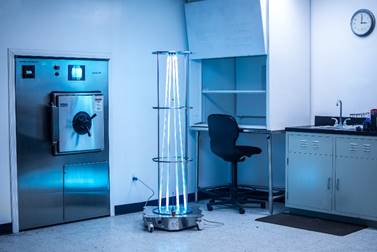
Coronavirus Technology Solutions
April 4, 2020
UV and ClO2 are Both Good
Decontamination Technologies for
Masks
H2O2 and Steam are Most
Promising Decontamination
Technologies
Anti-microbial Fiber from
Purafil
A Common Metric to Make
Coronavirus Decisions
______________________________________________________________________________
UV and ClO2 are Both Good
Decontamination Technologies for
Masks
David Shelep was a presenter in
the April 2 webinar on mask
reuse. He presented two
technologies which can
decontaminate masks. One uses UV
torches and is being utilized by
a hospital in Nebraska. The
other uses Chlorine Dioxide gas
in systems supplied by ClorDiSys.
UV will kill all organisms with
the proper dosage. The Nebraska
Medicine procedure using a room
and existing UV torch is easy to
implement.

The chlorine dioxide gas can
penetrate microscopic crevices
unlike most other treatment
alternatives.
H2O2 and Steam are Most
Promising Decontamination
Technologies
Jim Agalloco
provided a comparison of
various decontamination
strategies in the April 2
webinar. Based on availability,
performance and cost he
concluded that
•
Steam – uses hospital
sterilizers, available capacity
unknown, potential effects on
non-critical components unknown.
•
Vapor – retrofit room with H2O2
generator external, capacity
could be extensive, potential
effects on non-critical
components unknown.
•
Expecting a variable mix of N95
masks in any load, the effects
of steam or H2O2 can’t be
accurately predicted. Lots of
conflicting reports. Impact on
strap elastics is likely the
major factor in reuse.
He is concerned about whether
the H2O2 systems which are
presently being employed will be
sufficiently efficient.
Another concern is the likely
mix of masks.

Anti-microbial Fiber from
Purafil
Jeff Mathers submitted this
power point for presentation in
the April 2 webinar but was not
able to make the presentation.
The Puraward
anti-microbial fiber is
effective because
Synergistic Action -
Copper readily attacks the
proteins/amino acids of the cell
wall, allowing silver to invade
the cell more readily
Joint Attack Inside the Cell:
Sterilization:
Prevents replication
once silver has entered the
cytoplasm and reacts with
genomic DNA
Suffocation:
Causes failure of key enzymes
associated with respiratory
function
Starvation:
Causing the failure of key
enzymes associated with
transmittance of nutrients
across the cell wall
The material is used in both
masks and air filters.

A Common Metric to Make
Coronavirus Decisions
Bob McIlvaine explained a common
metric to measure all harm and
good in the April 2 webinar. A
McIlvaine study for one of the
largest healthcare companies on
single use vs reusable surgical
gowns is equally applicable to
masks. The study includes a
common metric to measure all
harm and good and to also
consider the future value
discount and tribal values.
Every alternative can be
measured in Quality Enhanced
Life Days. This includes the
discomfort of wearing a mask vs
the benefits.
It includes the possible
selection of Far UV to reduce
infection now even if it
increases the chance of skin
cancer many years into the
future.
It provides a clear
method for determining who gets
the ventilator and who does not.
The tribal value consideration
takes into account such
questions as should 3M
be required to ship
masks, they produce in other
countries back to the U.S.
It provides a method of
determining when and if the
risks of resuming the normal
work schedule are justified.
It is simple and
straightforward because it is
simply the aggregation of the
wishes of the majority
Relative to reusable gowns vs
disposable gowns it compares
greenhouse gas emissions from
gown manufacture to risk of
water contamination with the
washing of gowns.
